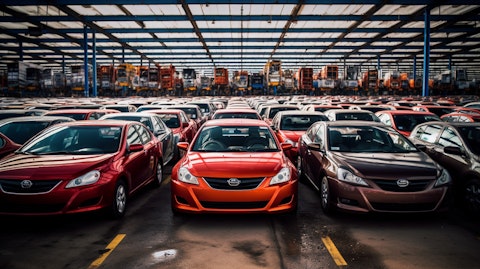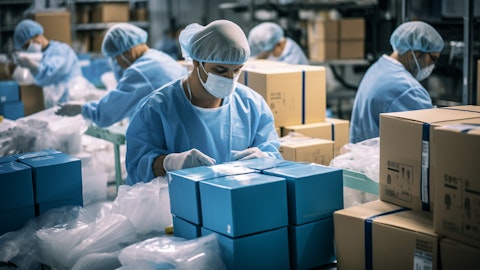Uxin Limited (NASDAQ:UXIN) Q2 2025 Earnings Call Transcript November 25, 2024
Operator: Good day, and welcome to the Uxin Third Quarter 2024 Earnings Conference Call. All participants will be in a listen-only mode. [Operator Instructions] Please note this event is being recorded. I would now like to turn the conference over to Jack Wang. Please go ahead.
Jack Wang: Thank you, operator. Hello everyone. Welcome to Uxin’s earnings conference call for the third quarter ended September 30, 2024. On the call today with me, we have D.K., our Founder and CEO; and John Lin, our CFO. D.K. will review business operations and company highlights, followed by John, who will discuss financials and guidance. They will both be available to answer your questions during the Q&A session that follows. Before we proceed, I’d like to remind you that this call may contain forward-looking statements, which are inherently subject to risks and uncertainties that may cause actual results to differ from our current expectations. For detailed discussions of the risks and uncertainties, please refer to our filings with the SEC. Now with that, I’ll turn the call over to our CEO, D.K. Please go ahead, sir.
Kun Dai: [Foreign Language] Hello, everyone. Thank you for joining us today. I’m pleased to reconnect with you all on this call. Before we start, I will be sharing our — as before, we will be sharing our company’s latest progress in both English and Chinese to accommodate our domestic and international investors. [Foreign Language] We’re excited to report another quarter of high-quality growth. From July to September 2024, our quarterly retail transaction volume reached 6,005 units, representing a sequential increase of 47% and a year-over-year growth of 163%. Our vehicle sales efficiency remains robust, with inventory turnover days maintained below 30 days, much lower than the Chinese industry average of 55 days to 60 days.
Our gross profit margin also expanded to 7%, marking a new high since we transitioned to our self-operated business. We anticipate that retail transaction volume in the next quarter will be 7,800 units to 8,100 units representing a year-over-year increase of over 150%. [Foreign Language] Customer satisfaction with purchasing vehicles from Uxin has remained at the highest level in the industry for 11 consecutive quarters with our Net Promoter Score rising to 66% this quarter. By leveraging advanced intelligent reconditioning factories to produce high-quality used cars, a comprehensive and reliable sales service system and the application of full-stack digital technology, our superstore model offers significant advantages over traditional car dealerships.
The sales conversion rate of customers visiting our stores exceeds 40%. As our base of transacting customers continues to grow, our positive reputation is reaching potential customers more rapidly, further consolidating our competitive advantage in regional markets. [Foreign Language] Importantly, used cars transactions have traditionally been considered non-standard processes. However, our efforts and achievements in standardizing the entire transaction process from inspection and reconditioning to sales, delivery and after-sale services has been increasingly recognized by the industry. Earlier this month, we had — we were honored to be named a corporate standard leader in China’s used car industry by 8 government ministries, including the State Administration for Market Regulation, the National Development and Reform Commission, the Ministry of Science and Technology, the Ministry of Industry and Information Technology, the Ministry of Finance and the People’s Bank of China.
We will continue to elevate our product and service centers, leading the high-quality development of China’s used car industry. [Foreign Language] We are also actively executing various business initiatives. First, we are steadily increasing our inventory levels to meet the strong consumer demand for car purchases. At the same time, by leveraging the one-stop transaction service environment of our off-line [super-stores] (ph), we are enhancing the penetration of value-added services to contribute more to our gross profit. Second, we’re gradually supplementing and optimizing our superstore staffing to accommodate the demands of our expanding business scale. Additionally, as our existing customer base growth, we’re further improving our service network by deploying additional maintenance service outlets in other areas of the cities where our super stores are located.

This allows us to be physically closer to our customers, meeting their daily vehicle maintenance and servicing needs. [Foreign Language] Driven by continuous sales growth, ongoing improvements in gross profit margin, and consistent expense optimization, we have achieved adjusted EBITDA profitability at the superstore level this quarter. We remain on track to achieve our goal of company-wide adjusted EBITDA profitability in the upcoming December quarter. [Foreign Language] Building on our proven superstore model, the expansion of our new superstores is progressing smoothly. Following our [corporation] (ph) agreement with the Zhengzhou Airport Economic Zone, we are pleased to announce that we have entered into another corporation agreement with the city of Wuhan.
Wuhan is a major city in Central China with a population of 14 million and vehicle ownership of 4 million. Additionally, Wuhan has a well-developed automotive industry value chain that is known as China’s Auto Valley, offering massive potential for business development. Our superstores in Zhengzhou and Wuhan are expected to commence operations next year. Furthermore, we are in discussions with several other cities. The expansion of new superstores will significantly enhance Uxin’s market presence in new regions, driving future sales growth and financial performance. [Foreign Language] And that concludes my remarks for today. And now I will let our CFO, John, to provide a closer look at our financials. John, please go ahead.
John Lin: [Foreign Language] Thank you, D.K. Hello, everyone. We will deliver our remarks in both Chinese and English to communicate better with you. And first, I would like to note that to better align with the common practice in the investment community, we have adjusted our fiscal year this quarter. Our fiscal year now runs from January 1 to December 31 each year, instead of the previous period from April 1 to March [21] (ph). [Foreign Language] For the period from July to September 2024, which is now the third quarter of fiscal year 2024, we once again delivered very strong growth. Transaction volume increased significantly on top of last quarter’s record high, quarterly retail transaction volume reached 6,005 units, representing a sequential growth of 47% and a substantial year-over-year growth of 163%.
[Foreign Language] This quarter, total retail vehicle sales revenue was RMB440 million, representing a sequential increase of 37% and a year-over-year increase of 79%. The average selling price of retail vehicles decreased from RMB109,000 in the same period last year to RMB74,000 this quarter. The strong increase in transaction volume had offset the impact of lower vehicle prices on overall revenue. [Foreign Language] As for the wholesale segment, our third quarter wholesale transaction volume was 1,041 units, a sequential decrease of 31% and a year-over-year decrease of 35%, with total wholesale vehicle sales revenue of RMB37.8 million. Combining retail and wholesale, total revenues for the third quarter were RMB497 million, representing a sequential increase of 24% and a year-over-year increase of 40%.
[Foreign Language] And this quarter, our gross profit margin was 7%, an improvement from the previous quarter. Importantly, our gross margin is on an upward trend. And with the market recovering and higher penetration of value-added services, we anticipate significant room for further improvement. [Foreign Language] And while our performance and operational efficiency has improved substantially, we continue to enforce strict cost and expense control. This quarter, our adjusted EBITDA loss was RMB9.2 million, a reduction of 73% quarter-over-quarter and 80% reduction year-over-year. [Foreign Language] Now looking ahead to the fourth quarter of 2024, our retail transaction volume is expected to continue its growth trend, reaching 7,800 units to 8,100 units with total revenues projected to be between RMB560 million and RMB580 million.
We also plan to achieve positive adjusted EBITDA for the company in the fourth quarter. [Foreign Language] And that concludes our prepared remarks for today. Thank you, everyone. Operator, we are now ready to begin the Q&A session.
Q&A Session
Follow Uxin Ltd (NASDAQ:UXIN)
Follow Uxin Ltd (NASDAQ:UXIN)
Receive real-time insider trading and news alerts
Operator: Thank you. We will now begin the question-and-answer session. [Operator Instructions] The first question today comes from Gary [indiscernible] with Water Tower Research. Please go ahead.
Unidentified Analyst: Hi, everyone. So we’ve seen that in previous years, China’s used car transaction volumes grew by double digits annually. But now in recent months, the growth rate has significantly slowed, think the year-over-year growth is like around 5% from January to September. So could you share whether the development of China’s used car market is slowing down or not, the reasons behind the trend and your outlook for the market’s future?
Jack Wang: All right. Thanks, Gary. Let me translate that question first. [Foreign Language]
Kun Dai: [Foreign Language] Okay. Thanks for the question. Yes, thanks for the questions. This is D.K. And this year, we have observed a moderation in the growth rate for both the new and used car transactions in China. And specifically, the production and sales of new cars has increased by approximately 2% year-over-year, while used car transactions have grown by about 5%. [Foreign Language] The primary factors contributing to the slowdown included fluctuations in the economic environment, which has somewhat suppressed consumer demand for cars. And additionally, the used car market faced headwinds due to price reductions in new cars during the first half of the year which impacted consumer sentiment towards purchasing used vehicles.
[Foreign Language] However, despite these short-term challenges, we remain highly confident in the long-term prospect of China’s used car market. First, China’s per capita car ownership is still less than one-third that of the United States and the overall car ownership in the country continues to rise. Second, the Chinese used car market is still in a very early stage of development. We expect it will maintain double-digit transaction volume growth in the coming years. In fact, since the second half of this year, we’ve already begun to see a rebound in used car transaction volumes. [Foreign Language] So for us, we’ve achieved around 150% year-over-year growth in retail transaction volume over the past few quarters. While our market share in the two cities where our current superstores are located, has exceeded 15%.
Our nationwide market share remains relatively low because we are currently focusing on deepening our presence through our off-line superstore model in these cities. And this indicates a significant headroom for growth. In the coming years, we plan to open several new superstores every year, which will drive sustained growth in our sales volume. And we believe that our sales growth rate will significantly outpace that of the overall market.
Jack Wang: And that’s our answer to the question. Operator, we can move on to the next.
Unidentified Analyst : Okay, thank you.
Operator: The next question comes from Fei Dai with TF Securities. Please go ahead.
Fei Dai: Hello D.K. [Foreign Language] Is encouraging to say the company expanding with new stores. Could you provide the timeline for the two new stores planned in Zhengzhou and Wuhan from construction to operating to achieving individual stores profitability? Also, what impact will this have on the company’s financial performance in 2025? Thank you.
John Lin: [Foreign Language] This is John, and I will address your questions. Both of our new stores are progressing as planned. The Wuhan store is expected to open in the first half of 2025. Well, the Zhengzhou store is anticipated to open in the second half of 2025. And now building on the experience of — experience and refinements from our superstore models in Xi’an and Hefei, we are fully — we’ve already fully validated this concept and accumulated valuable operational know-how. So as a result, we expect these new stores to reach breakeven within 6 months to 12 months after opening. [Foreign Language] Regarding the impact on our financial performance, this will largely depend on the rollout schedule of the new locations.
Prior to opening, we will need to invest operating capital primarily for purchasing equipment for reconditioning facilities and acquiring vehicles. This investment will be phased in gradually as our inventory levels grow. So the initial capital requirements for each new store won’t be substantial. We also anticipate a normal level of operating losses during the first six months after a store opens. But starting around the six months we expect the impact on our income statement to begin turning positive. [Foreign Language] Okay. So that’s our answer to your first question.
Fei Dai: [Foreign Language] Translate in English. Over the past few quarters, the company has consistently mentioned increasing inventory, with inventory assets growing by about 13% each quarter. I have two questions. The first is from a market demand perspective, how do you plan for upper limit of inventory levels in different cities? The second is, will the 30-day turnover rate decrease as inventory increased? And how does the company plan to balance inventory levels and turnover [its decisions] (ph)? Thank you.
Kun Dai: [Foreign Language] And this is D.K., and I will address that question. Our approach to planning inventory levels in different cities is closely tied to the local car ownership levels and our targeted market share in those regions. For example, in the city with approximately 500,000 registered vehicles and considering that new cars typically enter the used car market after about seven years, the annual used car transaction volume in the city will be around 70,000 units and this translates to approximately 4,000 units per month. [Foreign Language] In our existing markets like Xi’an and Hefei, we have achieved a market share exceeding 15% with an ultimate goal of surprising 20%. To put this into perspective and also to highlight our competitive advantage and effective business model, the leading used car companies in the US generally attain around a 3% market share only.
So based on these metrics, in cities with 500,000 vehicles capturing 20% of the monthly used car transaction which will be around 1,200 units supports the operation of a superstore with an inventory capacity of approximately 1,000 cars. In larger cities, such as Zhengzhou and Wuhan, where car ownership is around 5 million, our superstores can effectively manage inventory capacities of around 10,000 cars. [Foreign Language] So when entering a new city, we first established an inventory plan that aligns with the city’s car ownership levels and our market share objectives. We then progressively scale our inventory in-line with sales growth which helps us enhance market penetration while efficiently managing resources. [Foreign Language] Since March of this year, we have been steadily increasing our inventory levels.
By the end of September, our inventory was approximately double that of March end-levels. Notably, our monthly sales have more than doubled during the same period meaning sales growth has outpaced inventory growth. So we’ve actually achieved an acceleration in inventory turnover rather than a decrease. This is due to several factors. First, the market has been recovering with strong demand driving higher growth — higher sales volumes. And second, as we expand our scale, consumers benefit from a wider selection of vehicles available in our superstores. The increase of variety enhances our brand attractiveness, effectively making our stores the preferred destination for used car purchases. So as a result, more customers are drawn to our brand, improving sales efficiency.
Currently, the inventory levels at our two existing superstores have not yet reached their planned limits. So we aim to maintain an inventory turnover rate for around 30 days, even as we continue to increase inventory. And that’s our answer to your second question.
Operator: This concludes our question-and-answer session. I would like to turn the conference back over to the company for any closing remarks.
Jack Wang: All right. Thank you again for joining today’s call and for your continued support in Uxin. We look forward to speaking with you next quarter. Thank you.
Kun Dai: [Foreign Language] Thank you.
Operator: The conference has now concluded. Thank you for attending today’s presentation. You may now disconnect.
Follow Uxin Ltd (NASDAQ:UXIN)
Follow Uxin Ltd (NASDAQ:UXIN)
Receive real-time insider trading and news alerts





